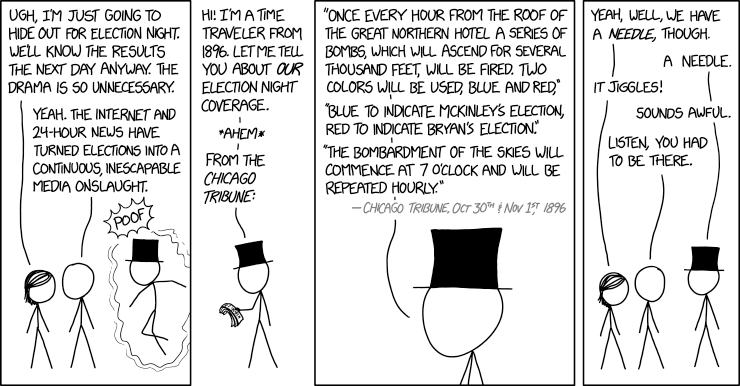This is the third comic in a row that deals with elections in the United States; the trio has been published in the week before the US midterm elections held on November 6, 2018 and it compares media coverage on election results in 1896 and 2018. During this time the Header text of xkcd was also changed three times, including on the release days of both this and the previous comic, to help people go and vote. See more in the trivia section.
While elections and voting have been a public staple for generations, election coverage by the media can result in voter fatigue. While voter fatigue is considered a major criticism of things like first past the post voting systems, media outlets will also contribute.
The time traveler from 1896, wearing a top hat (the typical hat used at that time), presents Megan and Cueball a method how the latest news --over the night-- is published to the public. No broadcasting television or even radio existed then and most newspapers, reaching the readers on the next morning, were printed in the evening before the election results were certain. For the election referenced in this clipping, Republican candidate William McKinley (assigned the color Blue) won in a close race against Democrat-Populist candidate William J. Bryan (assigned the color Red).
Here, Randall is taking a unique opportunity to point out that unlike our recollection of history (which is usually modified by the misinformation effect, where we perceive the past as being easier and find a source to blame for the election night jitters) that in fact, in the past, a bombardment of fireworks every hour was used to convey the hour-by-hour play of the election night, a significantly more jarring effect that couldn't even be turned off. We have progressed, in some ways, to a more opt-in system, rather than the opt-out system of the past, where you had to leave Chicago to avoid the news.
The part about the "jiggling needle" is likely a reference to the New York Times' 2016 presidential election results webpage. It displayed a "needle" representing a live election night forecast of the results of the presidential election between then-candidates Donald Trump and Hillary Clinton, jiggling to reflect uncertainty. The position of the needle was initially set based on pre-election polls, pointing heavily toward Hillary Clinton, but as election results from around the country -- and from individual counties within states -- started coming in it changed to reflect those results. In the 2018 midterm elections, the needle was once again used.
The title text explains that in 1896 even blind people were taken care of, as enormous megaphones were installed to convey the news equally unavoidably to those who couldn't (or didn't want to) see the color bombs. This is in fact true but was intended for those in the Coliseum, not all of Chicago.
